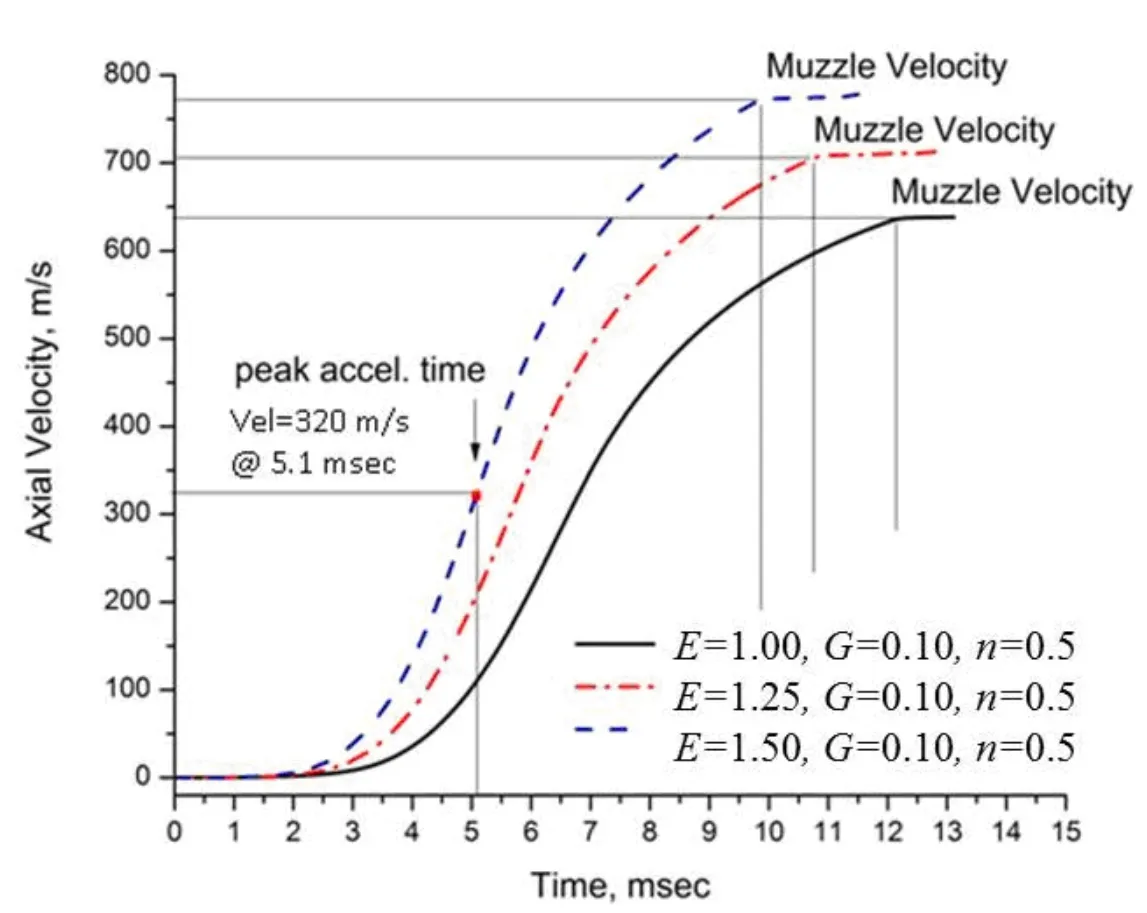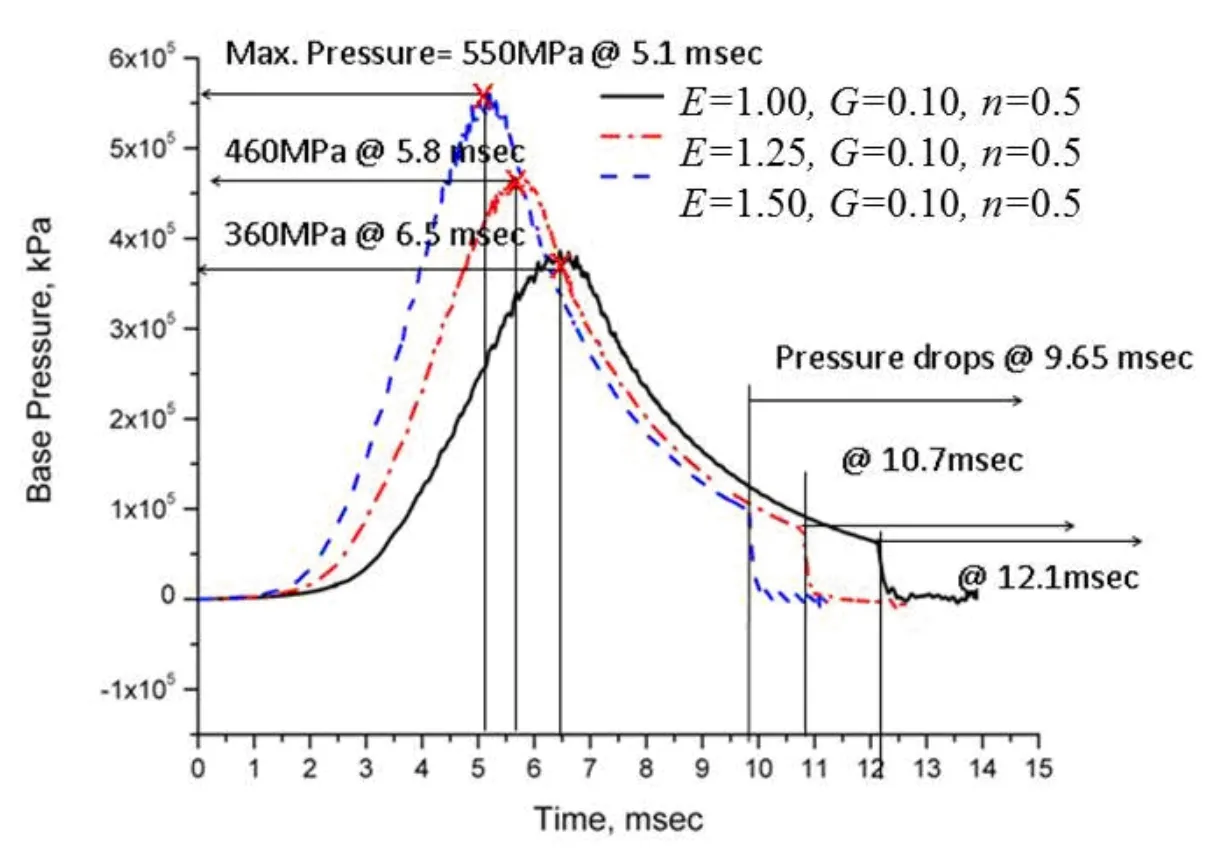Two-dimensional Eulerian-Lagrangian Modeling of Shocks on an Electronic Package Embedded in a Projectile with Ultra-high Acceleration
YIN Xue-wen,Pieter VERBERNE,Shaker A.MEGUID
(1 China Ship Scientific Research Center,Wuxi 214082,China;2 National Key Laboratory on Ship Vibration&Noise,Wuxi 214082,China;3 Department of Mechanical and Industrial Engineering,University of Toronto,5 King’s College Road,Toronto,Ontario,Canada,M5S 3G8.)
0 Introduction
The research paradigm is the smart artillery that carries chemical propellant,warhead,and electronic navigation and communication components.Upon ignition,the combustion of chemical propellant produces a large amount of high pressure gases in the combustion chamber,which is generally termed as fast pressurization process or projectile launch process.According to the experimental tests,during the projectile launch process,the projectile is subjected to axial acceleration that has a single pulse with a peak value of 15 000 g traveling within the confined volume,while it experiences an axial acceleration fluctuation of up to 5 000 g at muzzle exit during 12 msec.The severe pressurization loads greatly challenge the survivability of the embedded sensitive electronics within the projectiles especially when they are becoming more compact by increases in density and size reduction.
Experimental test can provide reliable results for design of fast pressurization systems and their interior components.However,they are very expensive and time consuming.Besides,it is very difficult to deploy measurement gauges within an accelerating projectile[7].With the development of computational capabilities during the past several decades,numerical methods such as finite difference method[8-9]and finite element method are becoming powerful alternatives to reproduce the complex physics of two-phase combustion and dynamics of hypervelocity objects.
Hollis[10]developed a two-dimensional axisymmetric finite element model for a training projectile,where maximum gas pressure during launch process was applied to its base.Chowdhury et al[2]developed a three-dimensional explicit finite element model of a surrogate Excalibur projectile,accounting for gun barrel interactions,gravity effects,and dynamics of interior subsystems.Chakka et al[11]proposed a transient numerical model for the prediction of shock transmission on the electronic payload within the projectile.Haynes and Cordes[12]and Chao et al[13]investigated the effect of potting materials on the dynamic responses of an electronic package.
These numerical studies provided good understanding of the dynamic characteristics of projectile accelerating including shock transmission to the interior electronic components.Nevertheless,in most of the above studies,the pressurization loads due to propellant combustion were simplified as a high-g impulsive pressure or acceleration based on assumed data or experimental data.According to Chakka et al[11],due to the design based on underestimation of launch loads,numerous failures of sensitive equipment within the projectiles were reported.In the other hand,overestimation of the launch loads leads to conservative design.Moreover,propellant properties play a major role[8-9]in the pressurization process including pressurization loads and the projectile accelerating.
In this paper,a two-dimensional axisymmetric Eulerian-Lagrangian finite element model[15]is developed to investigate the shocks on the electronic package embedded in a projectile,in which the entire pressure process is reproduced including both the physics of propellant com-bustion and the dynamics of the projectile accelerating.Through numerical simulations,the effect of major propellant property,i.e.,specific internal energy on the characteristics of the shock loads is investigated.The transmitted shocks to the payload during the launch process are also examined.
1 Finite Element Modeling
1.1 Model description
The actual projectile also has various electronic components at different locations that are responsible for guidance,navigation,and control.Moreover,as reviewed in the Introduction section,the dynamics of fast pressurization process involves:propellant combustion,projectile accelerating,solid-fluid interaction,and solid-solid interaction.It is very challenging or even impossible to address all these factors by considering all the details of the components within the projectile.Hence,it is necessary to make simplifications.Chakka et al[11]made great simplifications by eliminating the exact details of all the electronic components and modeled a single generic electronic component as a payload of one-pound solid mass.The payload was supported by a steel or composite plate that was fully attached to the ogive.Haynes and Cordes[12]and Chao et al[13]focused on dynamics of an electronic package within a supporting plate and the accelerations of the can container were used for the survivability evaluation of the electronics.In this paper,without loss of generality,we made the following simplifications:(1)The wall of the barrel is assumed rigid;(2)The electronic package is characterized as a solid payload supported by a laminated plate within the projectile;(3)The geometries of the propellant,the confined volume,and the projectile are axisymmetric;(4)The boundary conditions of the fluid domain and the projectile are also axisymmetric.
Hence,as shown in Fig.1,our simplified projectile model is composed of main body,an electronic package,and its supporting plate.The main body is a cylinder box and the electronics is simplified as a solid cylinder payload supported by a two-layered plate.The fast pressurization system is shown in Fig.2,which is composed of the propellant,projectile,confined volume,and a volume extension.The confined volume is employed to model the space within the rigid barrel wall.The volume extension is constructed to model the free space after the projectile exit the confined volume(barrel).
(3)#3主变失电。10kV3M无压、无流,若无闭锁信号523备自投装置充电完毕后,经3.0s延时跳开503开关,合上523开关。
1.2 Meshing

Fig.1 Sectional view of the electronics within the can structure of the projectile

Fig.2 Axisymmetric model of the fast pressurization system
ANSYS/Autodyn is used to simulate the dynamics of the projectile launch system(also known as fast pressurization system)shown in Fig.2.A two-dimensional axisymmetric finite element model is proposed in this paper.As shown in Fig.3,the electrical payload,the supporting plate,and the main body are specified with axisymmetric solid elements in Lagrangian type,which are filled with different materials as listed in Tab.1.The other parts such as the propellant,confined volume,and volume extension are defined as Eulerian type solid elements.Shown in Fig.4 are the meshes of propellant,which is ignited by a primer,marked in thick dashed line.The constitutive laws are defined according to Eqs.(1-4)in Section 1.4.To ensure accurate sold-fluid coupling,the Eluerian meshes should be finer than their Lagrangian counterpart.In this simulation,for the sake of computational considerations,the Eluerian mesh size is 20 mm×15.5 mm and the Lagrangian mesh size is 20 mm×7.75 mm.

Fig.3 Meshed model of the electronic package and can structure

Fig.4 Meshed propellant model

Tab.1 Material properties of different parts of the system
1.3 Boundary conditions
Fig.5 displays the boundary conditions on the confined volume and its extension.Flowout or pressure free boundary conditions are applied on the borders of the volume extension,which represents the free space.The solid-fluid boundary condition is automatically satisfied in ANSYS/Autodyn.In order to consider the interaction between the can carrier and the volume surface,radial displacement constraints are applied onto the exterior nodes of the projectile(shown in Fig.3).

Fig.5 Axisymmetric meshes for the confined volume and volume extension
1.4 Equations of state for the propellant
To address the physics of propellant burning,we used the slow burn model,in which linear compaction and exponential equations of state are employed for condensed phase and gas phase[14],respectively.
For the propellant,the reaction ratio at given time t is defined as the mass fraction of the burnt agent:

The reaction ratio is usually assumed as a function of burn rate b˙,reaction growth constant G,growth reaction exponent c,and the reaction ratio factor α in the following,

The burn rate is determined by Vieille’s law as follows:

where Pgis the pressure of reaction product,i.e.,gases,a and b0are constants,and n is the burn rate exponent.The equation of state of the reaction product is written as:

where ρgand egare the density and internal energy per mass,respectively,D is constant.The governing parameters of the propellant according to Eqs.(1-4)are listed in Tab.2.

Tab.2 Governing parameters of the propellant
2 Numerical results and discussion
In this section,projectile launch process is characterized by the numerical results of the projectile displacement,muzzle velocity,and acceleration.The effect of the internal energy of the propellant on the evolution of shocks is also investigated.The propellant specific energy is defined as the product of propellant density and internal energy,i.e.,ρgeg.E denotes the ratio of specific energy to its original value 1.0×106kJ/m3,for example,E=1.25 denotes that the propellant has 1.25 times of the original specific energy,and so on.Other parameters such as burn rate exponent,reaction growth constant,propellant density,etc.,are listed in Tab.2.
2.1 Characterization of projectile launch process
From Fig.2,the original location of the projectile base is 910 mm from the global origin,and the location of the muzzle is 4 200 mm from the global origin.Hence,the projectile displacement can be found from Fig.6 by the subtraction between the instant location and the original location of the projectile.From the dashed line in Fig.6,we can find that it takes nearly 9.65 msec for the projectile to completely exit the muzzle,totally travelling 3 190 mm.Corresponding to the muzzle exit,as shown in Fig.7,maximum velocity can be achieved,e.g.the value is 770 m/s when E=1.25.In addition,as shown in Fig.8,an abrupt acceleration drop appears ranging from 3 500 g down to nearly 0.0 upon muzzle exit.The cause for this remarkable acceleration drop can be traced back to sudden base pressure drop at Pt.1 shown in Fig.9.Hence,at muzzle exit time,both maximum projectile velocity and sudden acceleration drop can be achieved,which convinces the experimental and numerical findings by Cordes et al[3]and Chakka et al[11].

Fig.6 Axial displacement of the projectile at different propellant specific energies
Also from Fig.8,the projectile moves at maximum acceleration as much as 19 500 g at 5.1 msec,when the base pressure reaches its peak value as shown in Fig.9.It is very interesting that,from Fig.6,the projectile only moves 400 mm at 5.1 msec,nearly one eighth of the total projectile travel.From Fig.7,the projectile velocity at 5.1 mm is 320 m/s,less than one half of the its muzzle velocity.
Hence,the projectile launch process can be characterized as follows:upon ignition,the combustion of propellant can produce increasingly high pressure within the confined volume behind the projectile(shown in Fig.9);as a result,the projectile is accelerated to travel with increasingly high velocity(shown in Figs.7-8).Both the base pressure and projectile acceleration reach its maximum value at the same time,in which situation,the projectile hardly moves(only 400 mm)with relatively low velocity(320 m/s).

Fig.7 Axial velocity of the projectile at different propellant internal specific energies

Fig.8 Axial acceleration of the projectile at different propellant specific energies
In general,high acceleration is accused of the failure of electronic package[12-13].However,recently,high acceleration fluctuations after muzzle exit,was also reported as another major trigger of electronic failure[11].To address the survivability of the electronic package,we must examine the dynamic responses at a specific or local position instead of global responses,which are actually the average of all gauges that filter out the local fluctuations in responses.Shown in Fig.10,at a specific location,e.g.,Pt.2,we can find that the acceleration profile is quite different from global acceleration profiles shown in Fig.8.As shown in Fig.10,a lot of significant fluctuations are found in the acceleration profile at Pt.2 compared to the global ones in Fig.8.Comparing the global accelerations of the projectile shown in Fig.8 and the local accelerations at a specific position shown in Fig.10,we can deduce that the projectile globally moves forward while the projectile itself vibrates,which process can be manifested with the acceleration fluctuations based on the relatively smooth acceleration profiles shown in Fig.8.Our findings agree well with those from Chakka et al[11]and later Yin et al[15],who pointed out that the acceleration fluctuations are attributed to the shock waves due to the projectile launch process.

Fig.9 Base pressure(Pt.1)of the can at different propellant internal specific energies

Fig.10 Axial acceleration of the electrical payload(Pt.2)
2.2 Effect of propellant specific energy
Specific energy is one of the most important constants that characterize the physical properties of the propellant.Figs.6-10 show the effect of specific energy on the dynamics of the projectile launch process.In Fig.6,corresponding to different specific energies E=1.00,E=1.25,and E=1.50,it takes 12.0 msec,10.7 msec,and 9.65 msec for the projectile to travel 3 190 mm and then completely exit the confined volume,respectively.The higher is the specific energy,the earlier the projectile exits the confined volume.The reason can be found in Fig.7.The velocity of the projectile for higher specific energy is always larger than that for lower energy so that the projectile exits the confined volume earlier.The muzzle velocities for E=1.00,E=1.25,and E=1.50 are 640 m/s,705 m/s,and 770 m/s,respectively.
In Fig.8,increasing specific energy can achieve higher peak acceleration with shorter time duration.When E=1.50,the axial acceleration of the projectile reaches its peak value as much as 19 500 g at 5.1 msec while the acceleration peak values for E=1.25 and E=1.0 are 17 000 g at 5.8 msec and 13 800 g at 6.5 msec,respectively.From Figs.7-8,after muzzle exit,the projectile experiences significant acceleration drops but keeps maximum velocities in all cases.From Fig.9,base pressure also drops dramatically at different muzzle exit time.
Fig.10 displays the effect of propellant specific energy on the acceleration responses of the electrical payload(at Pt.2).As shown in Fig.10,in some situations,great acceleration fluctuations can also be found within the confined volume,which are similar to those fluctuations after muzzle exit reported by Cordes et al[5].The fluctuation amplitude for E=1.25 and E=1.50 is nearly 35 000 g,that is more than one and a half of the peak acceleration of the projectile.These two cases can produce even worse loads within the confined volume than those after muzzle exit because both maximum peak acceleration and higher fluctuations take place simultaneously.Further investigations on the relationship between the fluctuations and the shocks will be addressed in the future.Actually,as shown in Fig.3,Pt.2 is located in the supporting plate 2,representing the printed circuit board(PCB).So,the acceleration fluctuations at this location can be readily employed as one of the major criteria for the survivability evaluation of the electric package embedded with the projectile.
3 Conclusions
A two-dimensional axisymmetric Eulerian-Lagrangian finite element model has been developed to investigate the shock loads on electronic components within a projectile during fast pressurization process.Through numerical analysis,we find that the dynamics of the projectile accelerating agrees qualitatively well with those reported in experimental works.Most of the characteristics of the base pressure and the acceleration of the projectiles are identified,including acceleration fluctuations and pressure drops.Besides,the effect of the major propellant parameter,e.g.,specific internal energy,on the characteristics of projectile launch process is also examined.The work in this paper can be readily applied to the survivability of electronic equipment on ships subjected to underwater explosion without too many modifications.
[1]Liu Jianhu.Theory and its applications of ship dynamic responses to non-contact underwater explosions[D].Wuxi:China Ship Scientific Research Center,2002.
[2]Chowdhury M,Frydman AMR,Cordes J,et al.3-D finite-element gun lunch simulation of a surrogate Excalibur 155 mm guided artillery projectile-modeling capabilities and its implications[C]//22nd International Symposium on Ballistics.Vancouver,Canada,2005:259-267.
[3]Cordes J A,Vega J,Carlucci D,Chaplin R C.Structural loading statistics of live gun firings for the army’s Excalibur projectile[R].Armament Research,Development and Engineering Center Technical Report ARAET-TR-05005,2005.
[4]Cordes J,Vega J,Carlucci D,Chaplin R C.Design accelerations for the army’s Excalibur projectile[R].Armament Research,Development and Engineering Center Technical Report ARAET-TR-05008,2005.
[5]Cordes J,Morris S,Gast R,Carlucci D.Muzzle exit(set forward)effects on projectile dynamics[R].Armament Research,Development and Engineering Center,No.ARAET-TR-06003,2006.
[6]Laughlin,Kelly D.Characterization of the parameters that affect projectile balloting using finite element analysis[D].Ph.D.Dissertation,University of Oklahoma,2008.
[7]Peregino II P J,Bukowski E.Projectile-bore instrumentation for characterization of in-bore environments[C]//23rd International Symposium on Ballistics.Tarragona,Spain,2007:481-488.
[8]Robbins F W,Raab T S.A lumped-parameter interior ballistic computer code using the TTCP model[R].US Army Ballistic Research Laboratory Report BRL-MR-3710,1988.
[9]Jaramaz S,Mickovic D,Elek P.Two-phase flows in gun barrel:Theoretical and experimental studies[J].International Journal of Multiphase Flow,2011,37:475-487.
[10]Hollis M S L.Use of finite-element stress analysis in the design of a tank-cannon-launched training projectile[R].US.Army Research Laboratory Report,ARL-MR-149,1994.
[11]Chakka V,Tribia M B,O’Toole B,et al.Modeling and reduction of shocks on electronic components within a projectile[J].International Journal of Impact Engineering,2008,35:1326-1338.
[12]Haynes A S,Cordes J A.Characterization of a potting material for gun launch[C]//26th International Symposium on Ballistics.Miami,FL,2011:1038-1047.
[13]Chao N H,Cordes J,Carrlucci D,et al,The use of potting materials for electronic-packaging survivability in smart munitions[J].Journal of Electronic Packaging,2011,133:041003-1.
[14]ANSYS Autodyn Material Manual[K].Chapter 9,ANSYS Inc,2010.
[15]Yin X W,Verberne P,Meguid S A.Multiphysics modeling of the coupled behavior of precision-guided projectiles subjected to intense shock loads[J].International Journal of Mechanics and Materials in Design,2014,10(1):439-450.
- 船舶力学的其它文章
- DES Simulation of Flow Field of Propeller Tip Vortex
- Numerical Study on the Hydrodynamic Behaviors of a Ship Passing Through a Lock in Shallow Water
- Characteristics of Tendon Vortex Induced Vibrations Influenced by Platform Motion
- Mechanical Behavior of Flexible Jumper Installation in 3D Space
- Load-Compression Relationship of Incompressible Circular Rubber Pad Bonded between Rigid Plates
- Influence of Excitation Location on Sound Radiation of a Simple Duct Excited by Sound Source

